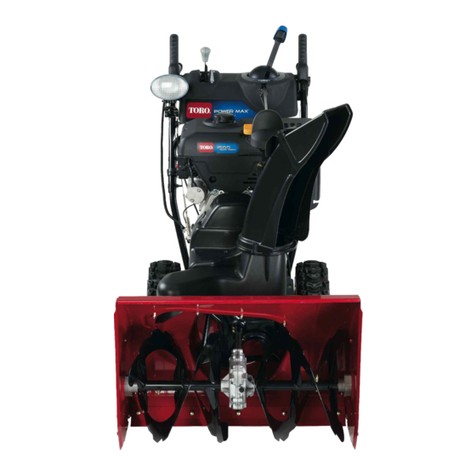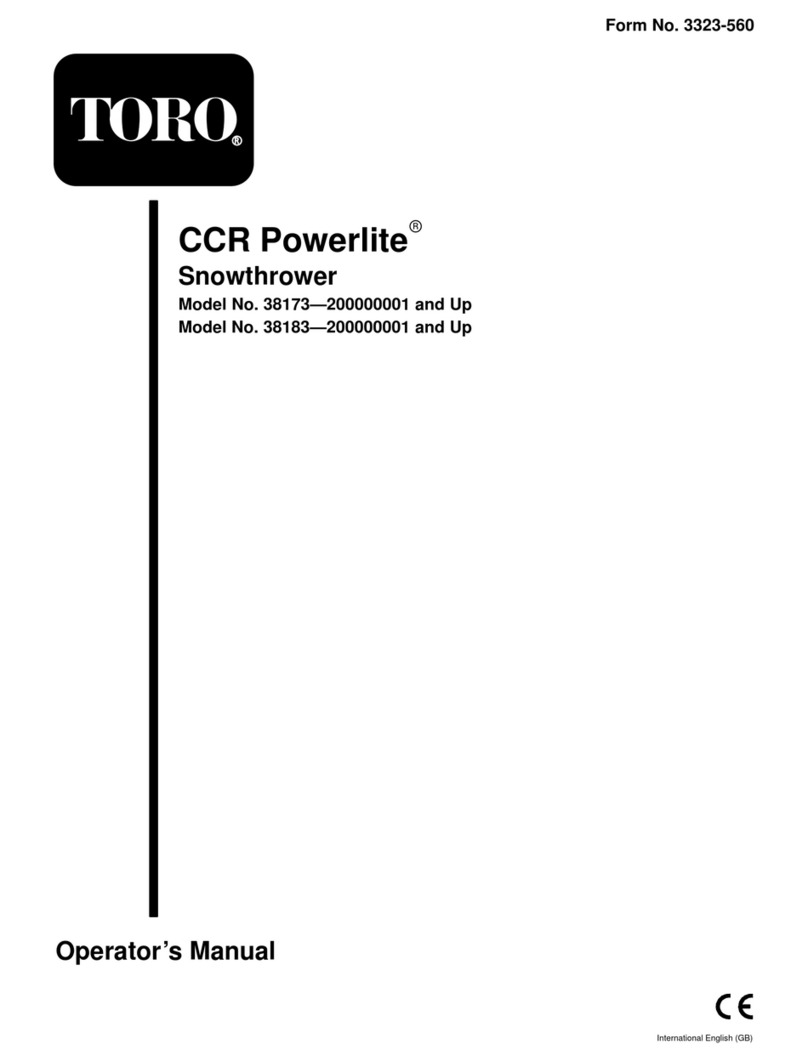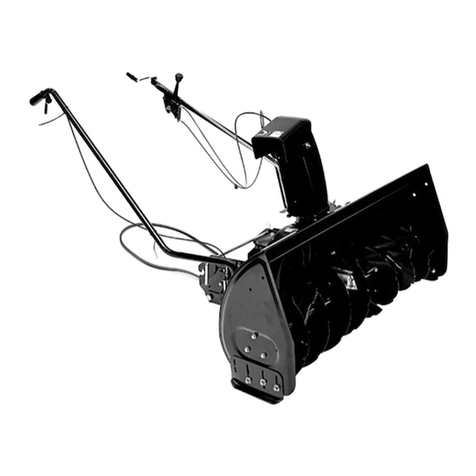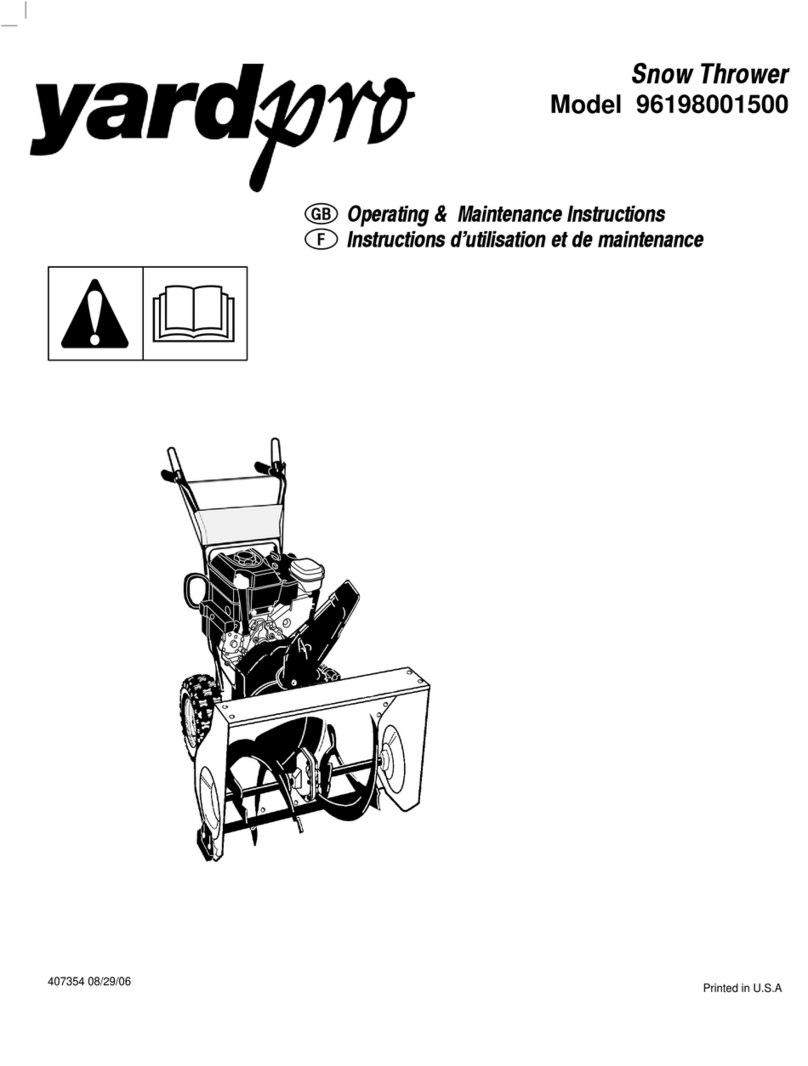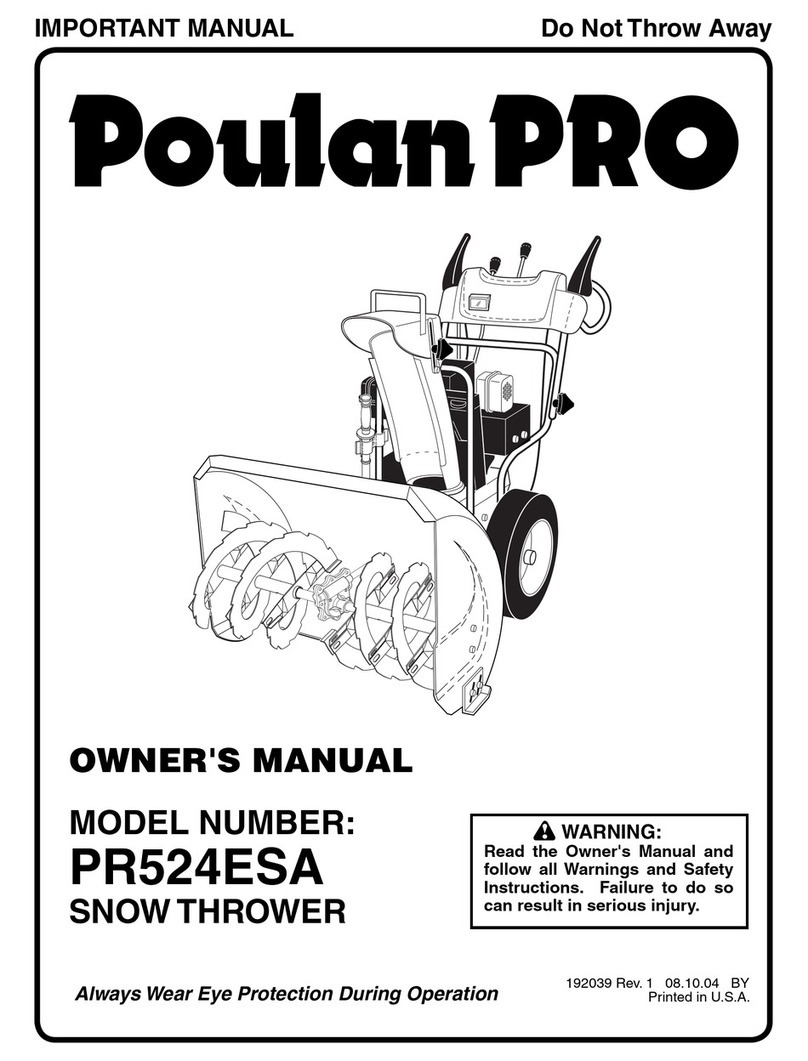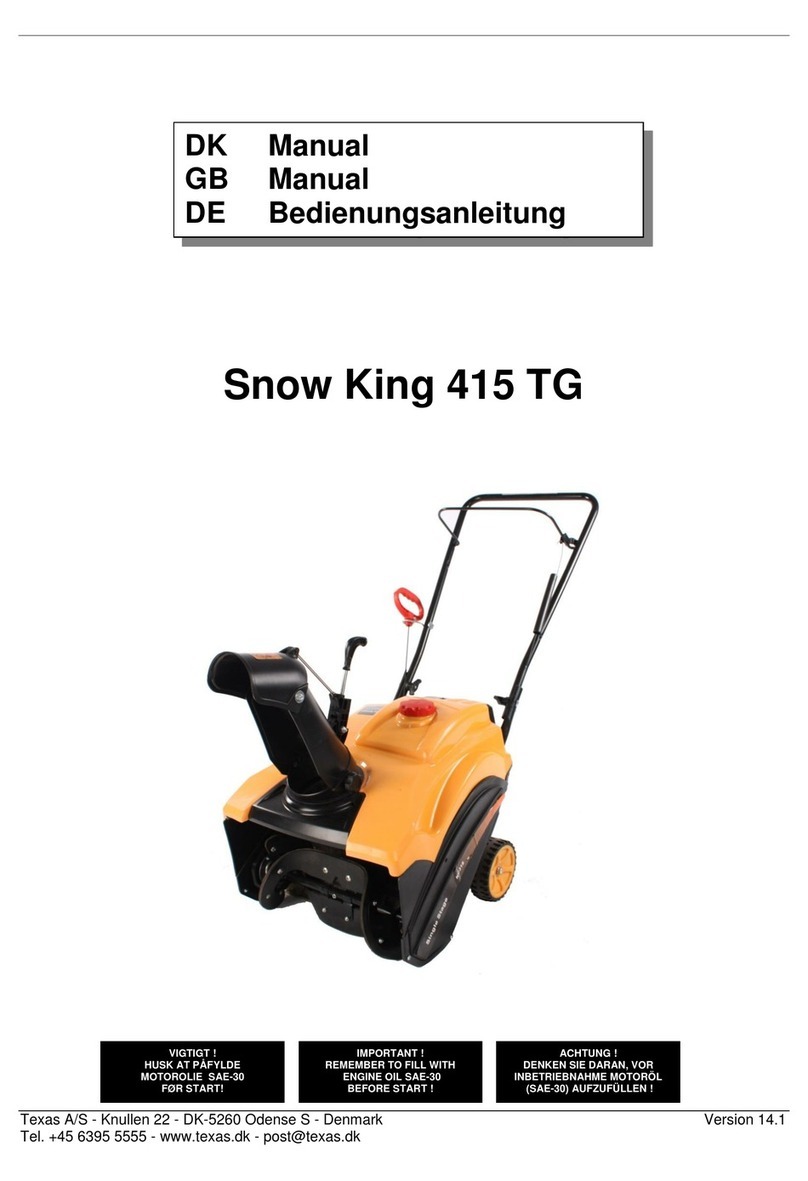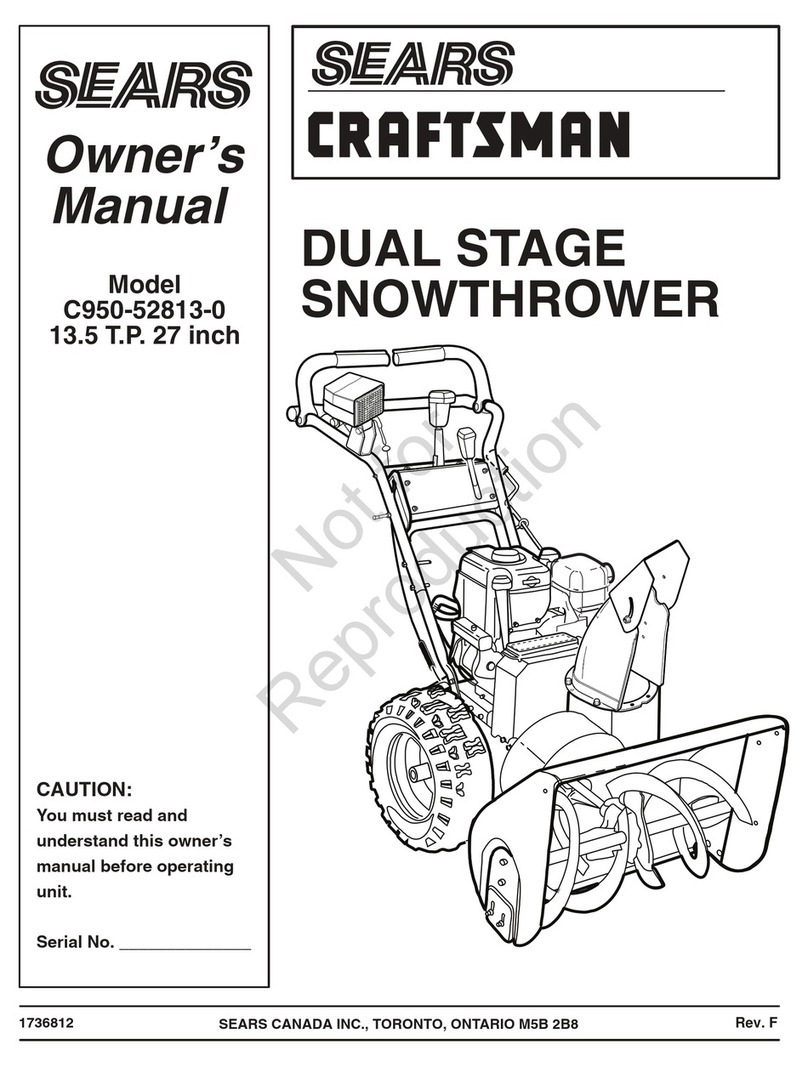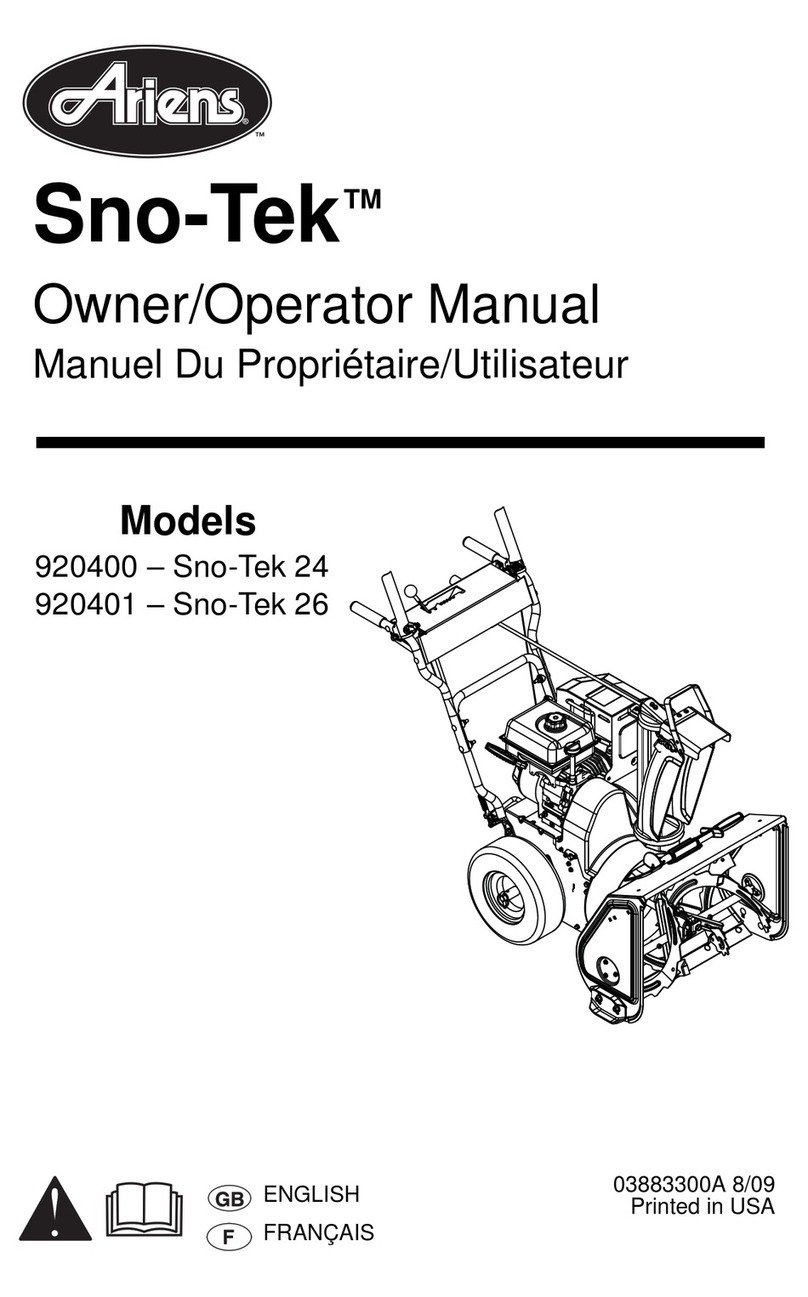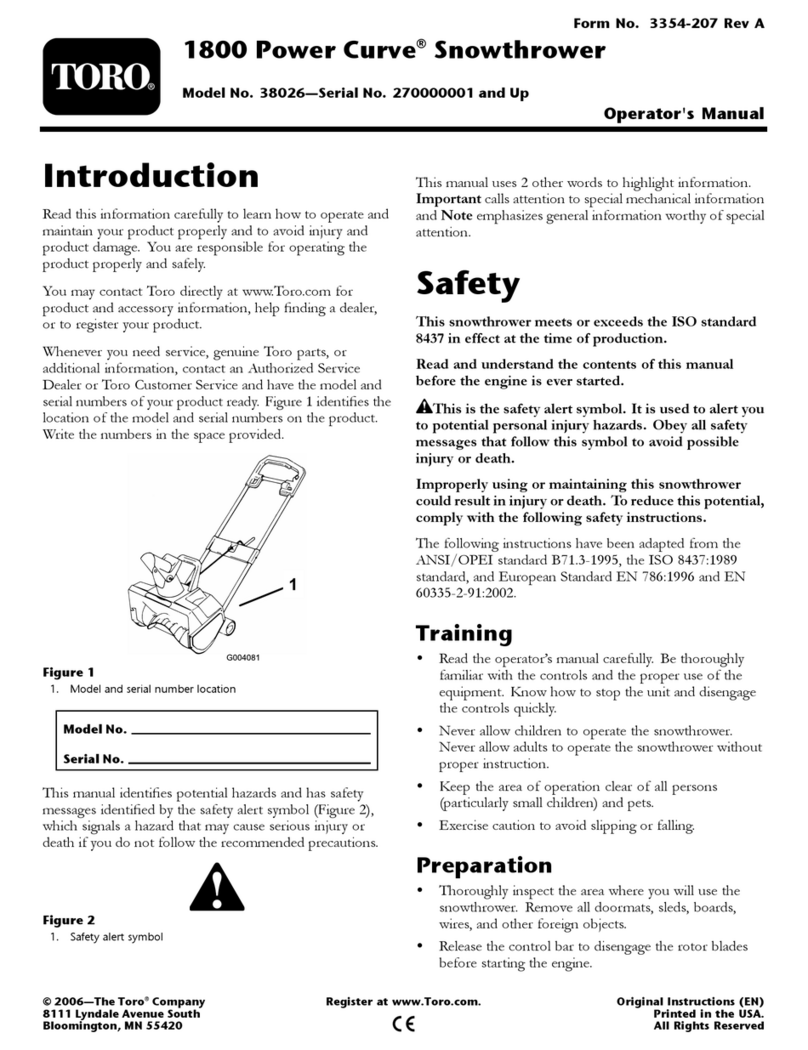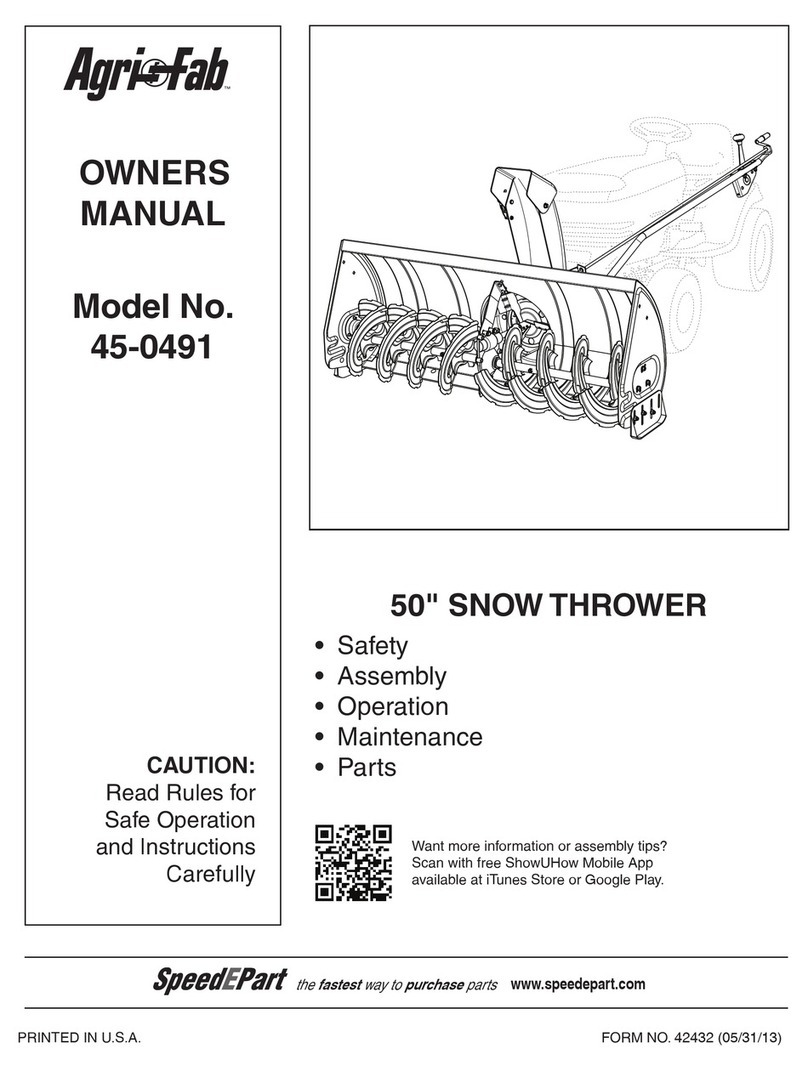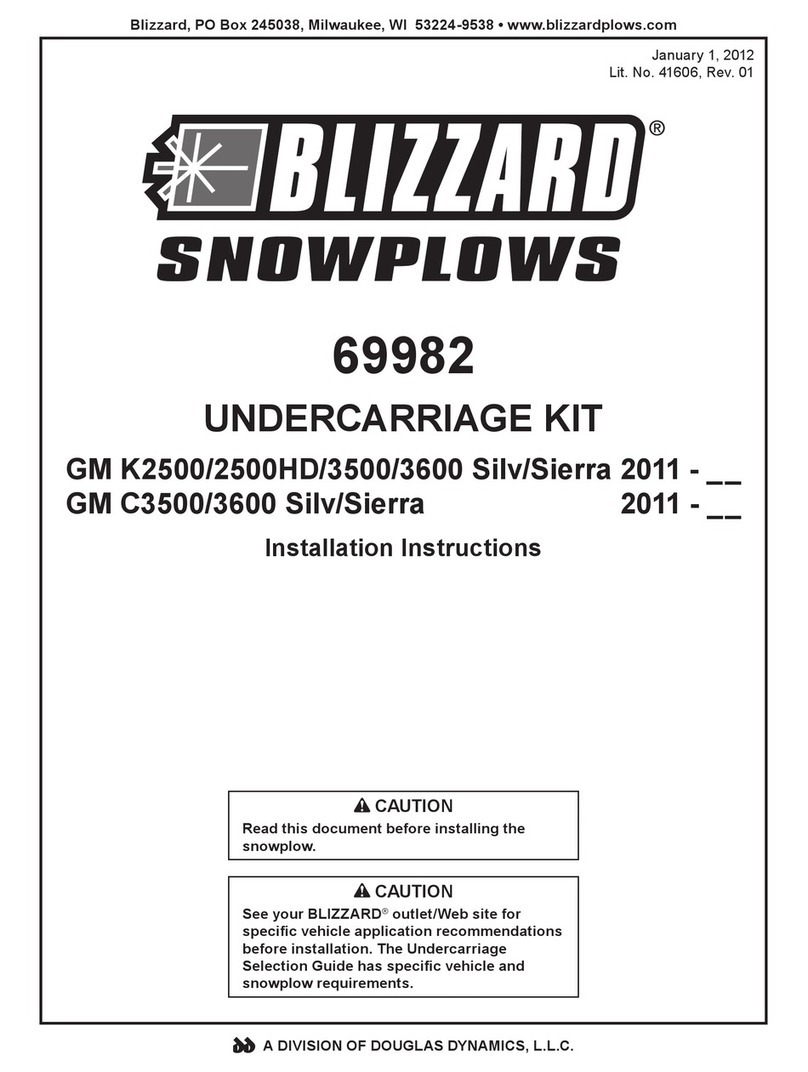Zeppelin ES70841 User manual

1INi
QUITANIEVES MOTOR
Operator's Manual
MODEL NUMBER: ES70841
SERIAL NUMBER
FOR YOUR SAFETY

m
TABLE
OF
CONTENTS
======
IEII
=====
IEII
========
111
•
lntroduction
Environmental
Symbols
Safety
Contents
supplied
Assembly
General
Safety
Rules
1111
Specific
Safety
Rules B
•
ID
Know
your
machine
lfl
Features
&
Controls
lfl
Adjustments
IDI
Operation
lfl
Freewheeling
and
Self-Propelling
lfl
Starting and
Stopping
the
Engine
IEI
Snow
Throwing
Tips
la
Traveling
EJ
Transport
EI
Maintena
n
ce
El
Servi
ce
Engine
EI
Lubrication
El
Battery
EI
Off-Season Storage
El
ID
Belt ReplacementEJ
Friction Wheel Replacement
BI
Charging
Battery
ID
Trouble
Shooting
El
El
Parts Schedule
,
This
operator's
manual
covers
severa/
mode/s.
Not
ali
features
in
this
manual
are
applicab/e
to
ali
snow thrower models
and
the snow
thrower
depicted
may
differ
from
yours.
n 2
-STAGE
SNOW
T
HROWER
INTRODUCTION
Your
new
snow
thrower
will
more
than
satisfy
your
expectations
.
lt
has
been
manufactured
under
stringent
quality
standards
to
meet
superior
performance
criteria.
You
will
find
it
easy and safe
to
operate, and
with
proper
care, it
will give
you
many
years
of
dependable service.
Carefully
read
through this
entire
operator's manual before using your
new
snow thrower. Take special care
to
heed
the cautions
and
warnings.
Your
snow
thrower
has
many
features
that
will
make
your
job
faster
and
easier.
Safety,
performance,
and
dependability
have
been
given
to
top
priority
in
the
development
of
this
machi
ne,
making
it
easy
to
maintain and operate.
The
Engine
manufacturer
is
responsible
for
ali
engine-related
issues
with
regards
to
performance
,
power
rating,
specifications,
warranty
and service. Please refer
to
the
Engine
Manufacturer's
owner's/operator's
manual,
packed
separately
with
your
unit,
for
more
information.
Specifications
ltem No. i
ES70á4i
•
IJ•M:f•ill•t.ffl-1
Clearing Width iii3
11
iff.J9ee•lii9,NffJ3
111
lntake Height
AugerDia.
lmpeller Día.
Speed
53.Scm
30.0cm
30.0cm
6F+2R
ENVIRONMENTAL
Recycle
unwanted
materials
instead
of
disposing
of
them
as
waste.
Ali
tools,
hoses
and
packaging
should
be
resorted,
taken
to
the
local
recycling
center
and
disposed
off
in
an
environment-friendly
safe way.

SYMBOLS
The
rating
plate
on
your
machine
may
show
symbols.
These
represent
important
information
about
the
product
or
instructions
on
its use.
Read
these
instructions
for
use
carefully
.
Wear
eye
protection.
Wear
hearing
protection.
Wear
safety
footwear.
Keep
bystanders
away
.
• .'
''
_
·~
~
Stop engine and remove ignition
~
11
key prior
to
leaving
the
operator's
position.
1
Only
use
clean-out
tool
to
clear
blockage.
Never
use
your
hands.
-
lt
is
forbidden
to
remove
or
tamper
with
the
protection
devices
and
safety
devices.
® Do
not
smoke
or
have open llames.
Do
not
touch
a
hot
muffler,
gear
housing
or
cylinder
.
Stop
engine,
remove
key,
read
manual
before
making
any
repairs
or
adjustments.
Keep
hands
out
of
the
inlet
and
discharge
openings
while
machine
is
running
.
Stay
away
from
rotating
augers.
Never
direct
discharge
towards
persons
or
property.
SAFETY
General Safety Rules
Understand your machine
Allow
operation
only
by
properly
trained
adult,
never
children.
Read
and
understand
the
operator's
manual
and
labels
affixed
to
the
machine.
Learn
its
application
and
limitations
as
well
as
the
specific
potential
hazards
peculiar
to
it.
Be
thoroughly
familiar
with
the
controls
and
their
proper
operation
.
Know
how
to
stop
the
machine
and
disengage
the
controls
quickly
.
Make
sure
to
read
and
understand
all
the
instructions
and
safety
precautions
as
outlined
in
the
Engine Manufacturer's Manual,
packed
separately
with
your
unit.
Do
not
attempt
to
operate
the
machine
until
you
fully
understand
how
to
properly
operate
and
maintain
the
Engine
and
how
to
avoid
accidental
1nJuries
and/or
property
damage.
Work
area
Never
start
or
run
the
engine
inside
a
closed
area.
The
exhaust
fumes
are
dangerous,
containing
carbon
monoxide,
an
odorless
and
deadly
gas.
Operate
this
unit
only
in a
well
ventilated
outdoor
area.
Never
operate
the
machine
without
good
visibility
or
light.
Never
operate
the
machine
on
a
steep
slope.
Personal safety
Do
not
operate
the
machine
while
under
the
influence
of
drugs, alcohol,
or
any
medication
that
could
affect
your
ability
to
use
it
properly.
Dress
properly.
Wear
heavy
long
pants,
boots
and
gloves.
Do
not
wear
loose
clothing,
short
pants.
and
jewelry
of
any
kind.
Secure
long
hair
so
it
is
above
shoulder
level.
Keep
your
hair,
clothing
and
gloves
away
from
moving
parts.
Loose
clothes.
jewelry
or
long
hair
can
be
caught
in
moving
parts
.
2-STAGE
SNOW
THROWER

Use
safety
equipment
.
Always
wear
eye
protection.
Safety
equipment
such
as a
dust
mask.
hard
hat.
or
hearing
protection
used
far
appropriate
conditions
will
reduce
personal
injuries.
Check
your
machine
befare
starting
it.
Keep
guards
in
place
and
in
working
order.
Make
sure ali nuts, bolts. etc. are
securely
tightened.
Disengage
ali
clutches
and
shift
into
neutral
befare
starting
the
engine
.
Never
operate
the
machine
when
it
is
in need
of
repair
or
is
in
poor
mechanical
condition.
Replace
damaged,
missing
or
failed
parts
befare
using it.
Check
far
fuel leaks. Keep
the
machine
in safe
working
condition.
Never
tamper
with
safety
device
.
Check
their
proper
operation
regularly.
Do
not
use
the
machine
if
the
engine's
throttle
control
does
not
turn
it
on
or
off.
Any
gasoline
powered
machine
that
can
not
be
controlled
with
the
engine
throttle
control
is
dangerous
and
must
be replaced.
Form
a
habit
of
checking
to
see
that
keys
and
adjusting
wrenches
are
removed
from
machine
area
befare
starting
it. A
wrench
or
a
key
that
is
left
attached
to
a
rotating
part
of
the
machine
may
result in personal injury.
Stay
alert.
watch
what
you
are
doing
and
use
common
sense
when
operating
the
machine.
Do
not
overreach.
Do
not
operate
the
machine
while
barefoot
or
when
wearing
sandals
or
similar
lightweight
footwear.
Wear
protective
footwear
that
will
protect
your
feet
and
improve
your
footing
on
slippery
surfaces.
Keep
proper
faoting
and
balance
at
ali
times
.
This enables
better
control
of
the
machine
in
unexpected
situations.
Avoid
accidental
starting
. Be sure
the
engine's
throttle
control
is
off
befare
transporting
the
machine
or
performing
any
maintenance
or
service on
the
unit.
Transporting
or
perfarming
maintenance
or
service
on
a
machine
with
its
throttle
control
on invites accidents.
2-STAGE
SNOW
THROWER
Fuel safety
Fuel
is
highly
flammable.
and
its
vapors
can
explode
if
ignited.
Take
precautions
when
using
to
reduce
the
chance
of
serious personal
1nJury.
When
refilling
or
draining
the
fuel
tank,
use
an
approved
fuel
storage
container
while
in
a clean.
well-ventilated
outdoor
area.
Do
not
smoke
,
or
allo
w s
park
s.
open
flames
or
other
sources
of
igniti
on near
the
area
while
adding
fuel
or
operating
th
e unit.
Never
fill fuel
tank
indoors.
Keep
grounded
c
ondu
c
tive
objects.
such
as
tools.
away
from
exposed. live electrical
parts
and
connections
to
avoid
sparking
or
arcing.
These
events
c
ould
ignite
fumes
or
vapors.
Always
stop
the
engine
and
allow
it
to
cool
befare
filling
the
fuel
tank.
Never
remove
the
cap
of
the
fuel
tank
or
add
fuel
while
the
engine
is
running
or
when
the
engine
is
hot.
Do
not
operate
the
machine
with
known
leaks
in
the
fuel
system
.
When
practica!,
remove
the
machine
from
the
truck
or
trailer
and
refuel
it
on
the
ground
.
lf
this
is
not
possible,
then
refuel
the
machine
on
a
trailer
with
a
portable
container.
rather
than
from
a fuel
dispenser
nozzle.
Loose
the
fuel
tank
cap
slowly
to
relieve
any
pressure in
the
tank
.
Keep
the
nozzle
in
contact
with
the
firm
of
the
fuel
tank
or
container
opening
at
all
times
until
fueling
is
complete.
Do
not
use a
nozzle
lock-
open
device.
Never
over
fill fuel tank. Fill
tank
to
no
more
than
12.Smm
(1/2")
below
the
bottom
of
the
filler
neck
to
provide
space
for
expansion
as
the
heat
of
the
engine
and/or
sun cause fuel
to
expand.
Replace
all
fuel
tank
and
container
caps
securely
and
wipe
up
spilled
fuel.
Never
operate
the
unit
without
the
fuel
cap
securely
in
place
.

Avoid
creating
a
source
of
ignition
far
spilled
fuel.
lf
fuel
is
spilled,
do
not
attempt
to
start
the
engine
but
move
the
machine
away
from
the
area
of
spillage
and
avoid
creating
any
source
of
ignition
until
fuel
vapors
have
dissipated.
Serious
personal
injury
can
occur
when
fuel
is
pilled
on
yourself
or
your
clothes
which
can ignite.
Wash
your
skin
and
change
clothes
immediately.
Store
fuel in
containers
specifically
designed
and
approved
far
this purpose.
Never
fill
containers
inside
a
vehicle
or
on
a
truck
or
trailer
bed
with
a
plastic
liner.
Always
place
containers
on
the
ground
away
from
your
vehicle
befare
filling.
Store
fuel
in a
cool.
well-ventilated
area.
Safely
away
from
sparks,
open
flames
or
other
sources
of
ignition
.
Never
store
fuel
or
machine
with
fuel in
the
•
tank
inside
a
building
where
fumes
may
reach
a
spark,
open
flame,
or
other
sources
of
ignition,
such
as a
water
heater,
furnace,
clothes
dryer
and
the
like.
Allow
the
engine
to
cool
befare
storing
in
any
enclosure.
Machine use and care
Never
pick
up
or
carry
a
machine
while
the
engine
is
running.
Do
not
force
the
machine
. Use
the
correct
machine
for
your
application.
The
correct
machine
will
do
the
job
better
and
safer
at
the
rate
for
which
it
was
designed
.
Do
not
change
the
engine
governor
settings
or
over-speed
the
engine.
The
governor
controls
the
maximum
safe
operating
speed
of
the
engine.
Do
not
put
hands
or
feet
near
rotating
parts.
Avoid
contact
with
hot
fuel, oil,
exhaust
fumes
and
hot
surfaces.
Do
not
touch
the
engine
or
muffler.
These
parts
get
extremely
hot
from
operation.
They
remain
hot
for
a
short
time
after
you
turn
off
the
unit.
Allow
the
engine
to
cool
befare
doing
maintenance
or
making
adjustments.
After
striking
a
foreign
object,
stop
the
engine,
remove
the
wire
from
the
spark
plug,
thoroughly
inspect
the
machine
for
any
damage,
and
repair
the
damage
before
restarting
and
operating
the
machine.
lf
the
machine
should
start
to
make
an unusual
noise
or
vibration,
immediately
shut
off
the
engine,
disconnect
the
spark
plug
wire,
and
check
for
the
cause. Unusual noise
or
vibration
is
generally
warning
of
trouble.
Use
only
attachments
and
accessories
approved
by
the
manufacturer.
Failure
to
do
so can result in personal injury.
Maintain
the
machine.
Check
far
misalignment
or
binding
of
moving
parts.
breakage
of
parts
and
any
other
condition
that
may
affect
the
machine
's
operation
.
lf
damaged,
have
the
machine
repaired
before
use.
Many
accidents
ar-e
caused
by
poorly
maintained
equipment.
Keep
the
engine
and
muffler
free
of
grass,
leaves, excessive grease
or
carbon
build
up
to
reduce
the
chance
of
a fire hazard.
Never
douse
or
squirt
the
unit
with
water
or
any
other
liquid. Keep handles
dry,
clean
and
free
from
debris
. Clean
after
each use.
Observe
proper
disposal laws
and
r~gulations
far
gas, oil. etc.
to
protect
the
environment.
Store
idle
machine
out
of
the
reach
of
children
and
do
not
allow
persons
unfamiliar
with
the
machine
or
these
instructions
to
operate
it.
Machine
is
dangerous
in
the
hands
of
untrained
users.
Service
Befare
cleaning, repair, inspecting,
or
adjusting
shut
off
the
engine
and
make
certain
ali
moving
parts
have
stopped.
Always
make
sure
the
engine's
throttle
control
is
in its STOP
position.
Disconnect
the
spark
plug
wire,
and
keep
the
wire
away
from
the
plug
to
prevent
accidental
starting
.
Have
your
machine
serviced
by
qualified
repair
personnel
using
only
identical
replacement
parts.
This
will
ensure
that
the
safety
of
the
machine
maintained.
2·STAGE
SNOW
THROWER

<
GB
Do
not
operate
without
wearing
adequate
winter
outer
garments.
Do
not
use
the
machine
on
a
roof
.
Do
not
run
the
engine
indoors,
except
when
starting
the
engine
and
for
transporting
the
snow
thrower
in
or
out
of
the
building
.
Open
the
outside
doors;
exhaust
fumes
are
dangerous.
Always
check
overhead
and
side
clearances
carefully
befare
operation.
Always
be
aware
o'f
traffic
when
operating
along
streets
or
curbs
.
Thoroughly
inspect
the
area
to
be
worked.
Keep
the
working
area clean
and
free
of
toys,
doormats,
newspapers.
sleds,
boards.
wires
and
other
foreign
objects.
which
could
be
tripped
over
or
thrown
by
the
auger/impeller.
Check
far
weak
spots
on
docks,
ramps
or
floors.
Plan
your
snow-throwing
pattern
to
avoid
discharge
toward
people
or
areas
where
property
damage
can occur.
Do
not
operate
near
drop-offs.
ditches.
or
embankments.
Machine
can
suddenly
turn
over
if
a
wheel
is
over
the
edge
of
a
cliff
or
ditch.
or
if
an
edge
caves in.
Keep ali bystanders, children. and
pets
at
least
23m
(75
feet)
away.
lf
you
are
approached,
stop
the
unit
immediately.
Use a
grounded
three-wire
extension
cord
and
receptacle
far
ali machines
with
electric
start
engines.
Check
clutch
and
brake
operation
frequently.
Adjust
and
service
as
required. AII
motion
of
drive
wheels
and
auger/impeller
must
stop
quickly
when
control
levers are released.
Let
engine
and
machine
adjust
to
outdoor
temperature
befare
starting
to
clear
snow
.
Stay
alert
far
hidden
hazards
or
traffic.
Do
not
overload
machine
capacity
by
attempting
to
clear
snow
at
too
fast
of
a rate.
Do
not
throw
snow
any
higher
than
necessary.
2·STAGE
S
NOW
THRO
WER
Adjust
auger
housing
height
to
clear
grave!
or
crushed
rock
surfaces.
Exercise
extreme
caution
when
operating.
Exercise
caution
to
avoid
slipping
or
falling,
especially
when
operating
in reverse.
Never
operate
machine
at
high
transport
speeds
on
slippery
surfaces
.
Always
look
down
and
behind
befare
and
while
backing
.
Do
not
operate
on
steep
slopes
.
Do
not
clear
snow
across
the
face
of
slopes
.
Keep
ali
movement
on
slopes
slow
and
gradual.
Do
not
make
sudden
changes
in
speed
or
direction.
Use a
slow
speed
to
avoid
stops
or
shifts
on
slopes.
Avoid
starting
or
stopping
on
a
slope
.
Do
not
park
machine
on
a
slope
unless
absolutely
necessary.
When
parking
on
a slope, always
block
the
wheels.
Disengage
power
to
the
auger/impeller
when
transporting
or
not
in use.
Disengage
ali
control
levers
and
stop
engine
befare
you
leave
the
operating
position
(behind
the
handles).
Wait
until
the
auger/
impeller
comes
to
a
complete
stop
befare
unclogging
the
chute
assembly,
making
any
adjustments.
or
inspections.
Hand
contact
with
the
rotating
impeller
inside
the
discharge
chute
is
the
most
common
cause
of
injury
associated
with
snow
throwers.
Do
not
unclog
chute
assembly
while
engine
is
running. Shut
off
engine
and
remain
behind
handles
until
ali
moving
parts
have
stopped
befare
unclogging.
Never
put
your
hand
in
the
discharge
or
collector
openings.
Always
use
the
clean-out
tool
provided
to
unclog
the
discharge
opening.

CONTENTS
SUPPLIED
The
snow
th
rower
comes
partially
assembled
and
is
ship
ped in
carefull
y pac
ked
carton
. After ali
the
parts
have
been
remo
v
ed
from
th
e
carton,
you
should
hav
e:
, I!§ 1 M
8X20
X311
Ali
reference to the Jeft
or
right side
of
the
snow
thrower
are
from
the
operator's position.
l.
Snow
Throw
er
Unit
2. Ha
ndl
eb
ar
s
3.
Shift
Lever
4.
Chute
Cr
ank
Lever
5.
Control
Panel
6.
Wh
eels (1pair)
7.
Dischar
ge
C
hut
e
8.
Chute
Clean-Out
T
ool
9.
Batt
e
ry
(if
so
equipped
)
10.
Operato
r's Manual & Engine Manual
11.
Engine
Hardwar
e Bag
12.
Snow T
hrower
Hard
wa
re Bag, lnclud
ing
(j):J
@ MlO X
20
:~-
~
©==
~
M
lO
X
40
- 0 0
M6
X
40
X4
El
¡¡,,,..
~
M6
X
30
:;-
¡¡...
ll)iQ)
M6
X2
5
p
c.b
M6
X30
::-
rJ::!)
~@)
:~
~
~
~
MS
()=
(to
MBX
25
X2
ljr:::i
(to
MSX
20
X2
-
!!]
11
X2
,~
:~
-
I= 6 X 37
X2
m
.,)
\_
2-STAGE
SNOW
THROWER
n

ASSEMBLY
Following
the
assembly
directions
below,
you
will
assemble
the
snow
thrower
in a
few
minutes
Engine
l.
Remove
wing
nut
and
washer
from
the
air
filter
cover.
2.
Rotate
the
air
filter
cover
by
180º
so
that
the
primer
faces outside.
3. lnstall air
filter
cover
and
tighten
wing
nut.
Handlebars
MlO X
20
MlO X
40
2-STAGE
SNOW
THROWER
X2
X2
l. Position
the
handlebars
against
the
left
and
ri
ght
sides
of
the
machine.
Align
the
holes
in
the
handlebars
with
the
side
plates
and
secure
handlebars
with
the
screws
and
the
washers
until
they
are
finger
ti
ght.
Remove
the
axle pins
and
slide
the
wheels
on
the
axle.
lnsert
each
axle
pin
through
the
hole in each wheel
hub
and
through
the
hole in
the
axle.
M6
X
40
X4
.
-
3.
Secure
control
panel
to
the
handlebars
with
screws,
washe
rs
and
nuts
until
they
are
finger
tight.
4.
Ensure
that
the
handles
are
at
the
same
height,
and
then
ti
ghten
ali
the
f
asteners
securely
.
...
-----------------------------------------------

5.
Slide
the
control cables
through
the
holes in
the
control panel. Make certain the cables are
seated properly in roller
gu
ides when
hook
the
cables
to
the
clutch levers.
Speed Shift Linkage
M6
X
25
X l
Remove
the
knob
to
sli
de
the
shift
le
v
er
through
the
slot
in
the
control
panel. Secure
shift
lev
er
to
the
shift
arm
wi
th
screws, washers
and
nuts. Replace
the
knob.
Discharge Chute
l. Grease
underside
of
discharge
chute
ri
ng
(
if
not
alr
eady
greased
).
2.
lnsta
ll
discharge
chu
te
over
opening
in the
auger
housing
and
secure
with
fasteners.
M8
X l
X2
Xl
2-STAGE
SNOW
THROWER

,
3.
Secure
the
upper
crank
lever
bracket
(attached
to
the
crank
lever)
to
the
upper
left
side
of
the
handlebar
with
a
locknut
and
two
curved
washers.
4.
Apply
grease
to
the spiral
of
the crank lever.
5. lnsert
the
spiral end
of
the
crank
lever
into
the
lower
bracket
and secure
with
the
flat
washer
and clevis pin.
Tires
The
tires
are
over-inflated
at
factory
for
shipping
purposes
.
Check
the
pressure in
the
tires
. Reduce
or
lncrease
equally
in
both
tires
to
the
manufacturer's
recommended
pressure.
Under
any
circumstance
do
not
exceedmanufacturer's recommended
pressure.
Ex
cessive pressure
when
A\.
seating
be
ads
may
cause
tire/rim
~
assembly to burst
wi
th force sufficlent
to
cause serlous lnjury.
Refer
to
side
wa
/1
of
tire forrecommendedpressure.
Equaltire pressure should
be
maintained
at a
li
times.
lf
the tire pressure
is
not
equal
in
both
tires,
themachine
may
not
travel in a straightpath
and
the scraper
b/ade maywearuneven/y.
K
eep
tires
free
of
gaso/ine
an
d oíl,
which can harm rubber.
Skid Shoes
l.
Move
the
machine
to
a level surface.
3.
Check
the
scraper
blade
adjustment.
The
scraper
blade
should
be
3mm
(1/8")
above
and
parallel
to
a level
ground.
To
adjust
the
scraper
blade, loasen
the
seven
mounting
screws
(two
on
each
side).
level
the
scraper
blade,
and
tighten
the
mounting
screws
.
M8 X 25
M8X20
X2
X2
X2
4.
Attach
both
skid
shoes
to
the
auger
side
plates
with
the
screws
and
nuts
.
Move
the
skid shoes
down
as
far
as possible. Be
sure
both
skid
shoes are
adjusted
evenly
.
Tighten
securely
.
Chute Clean-Out Tool
2.
Support
the
auger
blades so
that
they
are Fasten
the
clean-out
tool
to
the
mounting
clip
~
3mm
(1/8")
off
the
ground
. on
the
rear
of
the
auger
housing.
~~
--2-·S_T_A_G_e
__
s_N_o_'W
__
T_H_R_o_'W
__
E_R
__
____
__
______________________________
_

Replacement Shear
Pins
X2
X2
A
pair
of
replacement
auger
shear
pins
and
clevis pins are included
with
your
snow
thrower.
Store
them
in a safe place until needed.
Spare Roll
Pins
The
impeller
is
secured
to
the
impeller
shaft
with
roll pins.
6 X 37
X2
@:i
Two
6x37
roll
pins
for
impeller
are
supplied
as
spare
in
the
hardware
bag.
Store
them
in a
safe
place
until
needed.
Battery
(if
so
equipped)
l.
Remove
the
battery
cover
by
loosening
the
screw
and
nut.
2.
Take
battery
out
of
the
tray
.
M8X20
X3
3.
Attach
the
tray
to
the
auger
housing
wi
th
screws
and
nuts.
4. Replace
battery
on
the
tray.
5.
Connect
positive
(red)
battery
cabl
e
to
the
battery
te
rmi
nal f
ir
st.
then
ne
gat
i
ve
(black)
battery
cable.
Check
that
all
cable
connectors
are
tight.
6.
Reinstall
battery
co
v
er
and
tighten
the
scre
w
and
nut.
2·STAGE
SNOW
THROWER

i
i•itdlifm47
H!tMlii«A•itiRffi
Pins
e,,'ª
r
Gearcase
r
8/ade
ft@liMiW@Y
·
..
lgnition
Switc
idtMIM444
2·STAGE
SNOW
THROWER
•Jcea51•
MH44
iM4ii4@1
·
i·ree
#MidMI
i•ffe•I."'
MMMD
te
Deflector
Chute
De
ec
=M3-i44
Discharge
Skt

Speed Shift Lever
The speed shift lever has 8 positions: 6
forward
speeds and 2 reverse. To
change
speeds,
move
the
speed
shift
lever
to
the
desired
position.
The
lever
locks
in a
notch
at
each
speed
selection.
Always re/ease the drive clutch /ever
""
before
changing speeds. Failure
to
L,ll
dp
so
will
result in
damage
to
the
snow thrower.
Slower
speeds are
for
heavier
snow
and
faster
speeds are
for
light
snow
and
transporting
the
snow
thrower.
lt
is
recommended
that
you
use
a
slower
speed
until
you
are
familiar
with
the
operation
of
the
snow
thrower
.
1/1
1/1
lf
the
engine
slows
down
under
a
load
or
the
wheels
slip,
shift
the
machine into a
lower
gear.
lf
the front
of
the machine rides up,
shift the machine into a
lower
gear.
Jf
the front continues to ride up,
lift
up on the handles.
Discharge Chute Crank Lever
Rotate
the
discharge
crank
lever
clockwise
to
move
the
discharge
chute
to
the
left;
counterclockwise
to
move
the
chute
to
the
right.
Chute Deflector Handle
Move
the
deflector
handle
forward
to
move
the
snow
stream
down;
move
it
rearward
to
move
the
snow
stream
up.
Orive Clutch Lever
Squeeze
the
clutch
lever
against
the
handgrip
to
engage
the
wheel
drive
. Release
to
disengage.
Always release the drive c/utch lever
before
changing speeds. Failure
to
do
so will
result
in
damage
to
the
snow thrower.
Auger Clutch Lever
Squeeze
the
clutch
lever
against
the
handgrip
to
engage
the
auger
and
start
snow
throwing
action.
Release
to
disengage.
Scraper Blade & Skid Shoes
The
scraper
blade
allows
better
contact
with
the
surface
being
cleared.
lt
also
prevents
damage
to
the
housing
from
normal
use.
The
skid
shoes
are
located
on
each
side
of
the
auger
housing
and
control
the
distance
between
the
scraper
blade
and
the
ground.
Adjust
skid shoes
equally
to
keep
the
scraper
blade
level
with
the
ground.
The
scraper
blade
&
skid
shoes
are
subject
to
wear
and
damage.
Both
scraper
blade
and
skid
shoes
are
adjustable
to
compensate
for
wear
.
They
should
be
checked
and
adjusted
periodically. Replace
when
necessary.
2-STAGE
SNOW
THROWER
•

~
Damage to auger housing
wi/1
result
L,ll
if
scraper blade wears down too far.
Both
scraper
blade
and
skid shoes
have
two
wear
edges.
When
one
side
wears
out.
they
can
be
rotated
180°
to
use
the
other
edge.
Shear
Pins
The augers are secured
to
the
auger shaft
with
shear pins and clevis pins.
lf
the
auger
should
strike
a
foreign
object
or
ice
jam,
the
snow
thrower
is
designed so
that
the pihs
may
shear,
preventing damage
to
any
other
components.
lf
augers will
not
turn, check
to
see if
the
pins have
sheared. Replace
the
shear pins if necessary.
~
Do
not
substitute.
Use
only original
L.ll
equipment
shear pins as supp/ied
• with yoursnow thrower.
Auger
When
engaged,
the
augers
rotate
a
nd
draw
snow
into
the
auger
housing.
Discharge Chute
Snow
drawn
into
the
auger
housing
is
discharged
out
the
discharge
chute.
Chute Clean-Out Tool
Neve,
use
your
hands
to
clear
a
clogged discharge chute . Shut
off
engine
and
remain behind handles
until ali moving parts have stopped
before unclogging.
l°lllll'Eli
2·STAGE
SNOW
THROWER
The
chute
clean-out
tool
is
conveniently
fastened
to
the
rear
of
the
auger
housing
with
a
mounting
clip.
Should
snow
and
ice
become
lodged
in
the
discharge
chute
during
operation,
proceed
as
follows
to
safely
clean
the
discharge
chute
and
chute
opening:
l. Release
the
auger
clutch
lever
and
shut
off
the
engine.
2.
Remove the clean-out tool from the clip which
secures it
to
the rear
of
the auger housing.
3.
Grasp
the
tool
firmly
by
the
handle
and
push
and
twist
the
tool
into
the
discharge
chute
to
dislodge
the
blockage
.
4. Refasten
the
clean-out
tool
to
the
mounting
clip
on
the
rear
of
the
auger
housing.
5.
Make sure
the
discharge
chute
is
pointed
in a safe
direction
(no
vehicles,
buildings,
people,
or
other
objects
are in
the
direction
of
discharge)
.
Restart
the
engine.
While
standing
in
the
operator's
_
position
(behind
the
snow
thrower).
engage
the
auger
control
for
a
few
seconds
to
clear
any
remaining
snow
and
ice
from
the
auger
housing
and
the
discharge
chute.
Headlight
(if
so
equipped)
•
The
headlight
provides
added
safety
in
low-visibility
conditions.
Turn
the
headlight
switch
to
the
ON
position
to
actívate.
Drift Cutters
(if
so
equipped)

Drift
cutters
break
up
snow
drifts
that
are
taller
than
the
auger
housing
and
direct
the
snow
into
the
auger.
Store
the
drift
cutters
on
the
auger
housing
when
not
in use.
Reposition
drift
cutters
so
they
face
forward
as
shown.
Wing
nuts
should
be
fastened
on
the
outside
of
the
auger
housing.
Fuel Shutoff Valve
Always
operate
the
snow
thrower
with
the
fuel
shut-off
valve in
the
OPEN
position.
Close
the
valve
when
you
do
not
use
the
machine.
Throttle
Lever
Move
the
throttle
lever
to
the
right
to
increase
the
engine
speed;
move
it
to
the
left
to
decrease
the
engine
speed.
Move
the
throttle
lever
to
the
STOP
position
to
stop
the
engine.
Choke
Engage
choke
by
rotating
lever
to
FULL
position
whenever
you
are
starting
a
cold
engine
. As
engine
warms
up,
gradually
rotate
the
choke
to
the
OFF
position
.
Do
not
use
choke
to
start
a
warm
engine
.
& Never
use
choke to stop engine.
Primer
Press
the
primer
to
pump
additional
fuel
from
the
carburetor
to
the
cylinder
for
improved
cold
weather
starting
.
Recoil Starter
The
recoil
starter
is
on
the
back
side
of
the
engine.
Pull
the
recoil
starter
handle
to
start
the
engine.
Safety lgnition Switch
(if
so
equipped)
lnsert
the
safety
ignition
key
for
engine
to
start
and
run.
To
stop
the
engine,
remove
the
key.
ON/OFF
switch
(if
so
equipped)
Used
to
stop
the
engine.
Move
sw
itch
to
OFF
position
to
stop
engine.
Place
switch
in
ON
position
for
engine
to
start
and
run.
lgnition Switch
(12V
oc electric
start)
The
ignition
switch
is
operated
by
a
removable
key
which
has 3
positions
of
STOP, RUN
and
START.
Electric Starter &Start Button
(if
so
equipped)
The
electric
starter
will
start
a
properly
choked
and
cranked
engine
when
the
key
is
turned
(12V
DC)
or
start
button
(120V
or
230V
AC)
is
pushed.
To
start
the
machine,
connect
the
electric
starter
to
an
electric
power
source
with
an
approved
extension
cord
and
press
the
start
button.
Thoroughly inspect the
electrical
cord
befare
using the machine.
lf
the cord
is
damaged, do not operate
the machine. Replace
or
repair the
damaged cordimmediate/y.
Connect
extension
cord
to
th
e
electric
starter
p/ug-in
first
and
then to a
power
out/et; disconnect
the extension cord from the
power
out/et
first
and
then
from
the
machine.
To
prevent
damaging
the
e/ectrlc
starter,
do
not
run
it
more
than
& 5
continuous
seconds
each
time
•
you
try
to
start.
Wait
10 seconds
between each attempt.
2-STAGE
SNOW
THROWER
-

Adjustments
~~~~~ ~~~~~
Skid Shoes
Position
the
skid
shoes
based
on
surface
conditions.
For
removal
of
snow
in
normal
conditions.
such
as a
paved
driveway
or
sidewalk.
place
skid
shoes
in
the
higher
position
to
give
a
3mm
(1/8")
clearance
between
the
scraper
blade
and
the
ground.
Use a
middle
or
lower
position
when
the
area
to
be
cleared
is
uneven.
such
as a
gravel
driveway.
lt
is
not
recommended to operate
the snow
thrower
on
grave/
as
it
can
easily pick up and throw by the
impeller, causing personal injury
or
~m~e~Me~o
w
Mrow~~d
surrounding property.
lf
you
choose
to
operate
the
snow
thrower
on
a
gravel
surface,
use
extra
caution
and
keep
the
skid s
ho
es
in
position
for
maximum
clearance
between
the
ground
and
the
scraper
blade
.
Alw
ays
adjust
ski
d shoes
after
~
ad
justing scraper blade to
prev
e
nt
~
premature wear to scraper blade
or
damage
to
auger housing.
To
adjust
the
skid shoes:
....,.
2·STAGE
SNOW
THROWER
l.
Loosen
the
four
hex
nuts
(two
on
each
side)
and
carriage
bolts.
Move
skid shoes
to
desired
position
.
2.
Make
sure
the
entire
bottom
surface
of
skid
shoe
is
against
the
ground
to
avoid
uneven
wear
on
the
skid shoes.
3.
Retighten
nuts
and
bolts
securely.
Auger Clutch and Orive Clutch
When
auger
clutch
lever
or
drive
clutch
lever
is
released
and
in
the
disengaged
position,
the
cable should have
very
little
slack.
Auger
must
stop
within
5
seconds
when
the
auger
clutch
lever
is
released.
lf
auger
clutch
does
not
engage
or
disengage
properly,
adjust
auger
clutch
before
operation
.
lf
the
snow
thrower's
drive
is
disengaging
intermittently
during
operation,
or
it
drives
when
you
release
the
drive
clutch
lever,
adjust
the
drive
clutch
before
operation
.
Both
auger
clutch
and
drive
clutch
can
be
adjusted
as
follows:
'
1
1 1
L :
,,J
l. Loosen
jam
nut
on
adjustment
turnbuckle.
2.
Turn
the
adjustment
turnbuckle
up
and
down
to
increase cable tension
or
provide
more
slack.
3.
Retighten
jam
nut.

r
l
Chute Bracket
lf
the
spiral
at
the
bottom
of
the
chute
crank
lever
is
not
fully
engaging
with
the
chute
assembly,
the
chute
bracket
can
be
adjusted.
•
••
•
To
do
so:
l. Loose
the
two
nuts
which
secure
the
chute
bracket
and
reposition
it
slightly
.
2.
Retighten
the
nuts.
Fr
eew
heeling
and
Self-Propelling
Use
the
axle
lock
pin
to
lock
or
unlock
the
right
or
Jeft
wheel
.
Lock
both
wheels
to
increase
traction;
unlock
one
wheel
to
allow
for
easier
turning
of
the
unit;
unlock
both
wheels
for
freewheeling
.
To
unlock
wheel, slide
it
inward
and insert
the
axle
pin
through
the
outer
axle hole,
but
not
through
the
wheel hub.
To
lock
wheel, slide
it
outward
and insert
the
axle pin
through
the
hole
in
the
wheel
hub
and
the
outer
axle hole.
2·STAGE
SNOW
THROWER

Starting
and
Sto
pp
in
g
the
Engin
e
Before
startlng
the
engine,
check
engine
oil
leve/
and
ensure
the
engine
Is
served
as
described
In
the
Englne
Manual
with
the
snow
blower.
Cold Start -Electric
Starter
(120V
or
230
AC)
(if
so
equipped)
The
engine
is
equipped
with
both
A.C.
electric
starter
and
a recoil
starter.
The
electric
starter
is
equipped
with
a
three-wire
power
cord
and
plug
and
is
designed
to
operate
at
the
voltage
shown
in
the
!abe!.
Do
not
use
the
electric
starter
if
~
your
househ
old
voltage
different
Lll
from the one shown on the electrlc
starter.
l.
lnsert
safety
ignition
key
into
ignition
slot
until
it
clicks. Do
not
turn
the
key
2.
Be
sure
fuel
shutoff
valve
is
in
the
OPEN
position
.
3.
Move
choke
control
to
FULL
position.
4.
Push
the primer2
or
3 times. When temperature
is
below
-25ºC
(15ºF). additional
priming
may
be
needed.
When
temperature
is
above
lOºC
(SOºF),
priming
is
not
necessary.
Over
priming
may
cause f/ooding,
preventing the engine from starting.
lf
you
do
f/ood
the
engine,
wait
a
few
minutes
before
attempting
to
start
and
do
not
push the primer.
Sorne snow engine
is
not
equipped
with primer
as
priming
is
not
needed
for such engine.
5.
Connect
the
extension
cord
to
the
engine.
6.
Plug
the
other
end
of
the
extension
cord
into
a
three-wire
grounded
receptacle.
7. Push
starter
button
until
engine
starts.
~
2·STAGE
SNOW
THROWER
To
prevent
damaglng
the
electrlc
~
starter,
do
not
run
lt
more
than
Lll
S
continuous
seconds
each
time
you
try
to
start.
Walt
10 seconds
between each attempt.
8.
When
the
engine
starts, release
the
starter
button
and
slowly
move
the
choke
control
to
the
OFF
position.
9.
Disconnect
the
extension
co
rd
from
the
receptacle
first,
then
from
the
engine.
Cold Start -Electric Starter (12V DC)
Cif
so equipped)
l.
Be
sure
fue!
shutoff
valve
is in
the
OPEN
position.
2.
Move
choke
control
to
FULL
position.
3.
Push
the
primer
2
or
3
times
.
When
temperature
is
below
-25ºC
(15ºF).
additional
priming
may
be
needed.
When
temperature
is
above
lOºC
(50ºF).
priming
is
not
necessary.
Over
priming
may
cause flooding,
preventing the engine from starting.
lf
you
do
f/ood
the engine,
wait
a
few
minutes
before
attempting
to
start
and
do
not
push the primer.
Sorne snow engine
is
not
equipped
with primer
as
priming
is
not
needed
for such engine.
l 4.
Turn
ignition
key
to
the
ST
ART
position
until
engine
starts.
To
pre
ve
nt
damagin
g
the
e/ectrl
c
~
starter,
do
not
run
lt
more
than
Lll
S
contin
uous
seconds
each
time
you
try
to
start.
Wait
10 seconds
between each attempt.
5.
When
the
engine
starts. release
the
ignition
key
into
RUN
position
and
slowly
move
the
choke
control
to
the
OFF
position.

Cold Start -Recoil Starter
1.
Be
sure
fuel
shutoff
valve
is in
the
OPEN
position.
2.
Place ON /
OFF
switch
in ON position.
3.
Rotate
choke
control
to
FULL
position.
4.
Push
the
primer
2
or
3
times.
When
temperature
is
below
-25
ºC
(15ºF),
additional
priming
may
be
needed
.
When
temperature
is
above
lO
ºC
(5
0ºF),
priming
is
not
necessary.
,
Over
priming
may
cause
f/ooding,
preventing the engine from starting.
lf
you
do
f/ood
the
engine,
wait
a
few
minutes
before
attempting
to
start
and
do
not
push the primer.
5.
Grasp
recoil
starter
handle
and
pull
rope
out
slowly
until
it
pulls
harder.
Let
rope
rewind
slowly.
6. Pull
rope
with
a
rapid
continuous
full
arm
stroke.
Do
not
allow
starter
rope
to
snap
back.
7.
Repeat
steps
5
and
6 until
engine
starts
.
8.
When
the
engine
starts. release
the
recoil
starter
handle and
slowly
move
the
choke
control
to
the
OFF
po
sition.
Warm
Start
Follow
the
steps
above
,
keeping
the
choke
control
in
the
OFF
position
and
do
not
use
primer
,
,
Allow
the
engine
to
warm
up
for
a
few
minutes, engine
wi/1
not
develop
ful/
power
until
it
has
reached
normal
operating temperature.
In
sno
wy
and
cold
conditions,
sorne
controls
and
moving
parts
may
freeze.
Do
not
use
excessive
force when trying to
operate
frozen
controls.
Jf
you
have
difficulty
operating
any
control
or
part,
start
the
engine
and
Jet
is
run
for
a
few
minutes.
Snow Throwing Tips
lt
is
easier and
more
efficient
to
remove
snow
immediately
after
it
falls.
The
best
time
to
remove
snow
is
the
early
morning.
At
this
time
the
snow
is
usually
dry
and
has
not
been
exposed
to
the
direct
sun
and
warming
temperatures.
Slightly
overlap
each
successi
ve
path
to
ensure ali
snow
will be
removed.
For
large areas,
start
in
the
middle
and
throw
snow
to
each
side,
so
snow
is
not
cleared
more
than
once.
For
e
xt
remely
heavy
snow,
reduce
the
width
of
snow
removal
by
overlapping
previous
path
and
moving
slowly.
Throw
snow
downwind
whenever
possible.
Keep
engine
clean
and
clear
of
snow
during
use. This will
help
air
flow
and
extend
engine
life.
After
snow-throwing
is
completed,
let
the
engine
run
for
a
few
minutes
to
help
dry
off
the
moisture
on
the
engine
and
prevent
moving
parts
from
freezing
.
Engage
the
auger
to
clear
any
remaining
snow
from
inside
the
housing.
Rotate
the
discharge
chute
to
prevent
it
from
freezing
.
Stop
the
engine
,
wait
for
ali
moving
parts
to
stop,
and
remove
ali
ice
and
snow
from
the
snow
thrower.
With
the
engine
off.
pull
the
recoil
starter
handle
severa!
times
to
prevent
the
recoil
starter
from
freezing
up.
2-
ST
AG
E S
NOW
T
HROW
ER
~

Traveling
To
travel
from
one
work
area
to
another:
l.
Set
throttle
to
sl
ow
or
part-throttle
position
.
2.
On
wheeled
model
, press
down
on
handle
bars
enough
to
raise
front
of
unit
slightly
off
surface;
on
tracked
model.
move
the
track
lock
lever
into
the
transport
position.
3.
Engage
drive
clutch
without
engaging
auger
clutch.
Transport
~~~-
-~~~~~--
Al
ways shut
off
englne,
remove
~
key,
and
e/ose fue/
shut-off
va/ve
~
when transporting unit on a truck
or
tralle
r.
Do n
ot
transpo
rt
mach
ln
e
while engine
is
runnlng.
Use
extra
care
when
loading
or
unloading
unit
onto
trailer or
truck.
Secure
unit
chassis
to
transport
vehicle.
Never
secure
from
rods
or
l
inkages
that
could
be
damaged.
I~
2-STAGE
SNOW
THROWER
Refer
ro
the
Engine
Operator's
Manual.
Lubrication
Auger Gearbox
Th
e ge
arbo
x
was
f
illed
with
Jubricant
to
th
e
proper
level
at
the
factory.
Unless
there
is
ev
idence
of
leakage
or
service
has
been
performed
on
the
gearbox.
no
additional
lubricant
should
be
required.
lf
J
ubr
i
cant
is
requ
ir
ed.
use
GL-5
or
GL-6
, SAE8
5-95
, EP
gear oíl
lubri
cant. Do n
ot
use sy
nth
et
ic o
íl.
General Lubrication
Lightly
lubricate
ali
moving
pa
rts
of
the
machine
at
the
end
of
the
season
or
e
very
25
oper
a
ting
ho
ur
s.
~Oil
\ Grease
Table of contents
